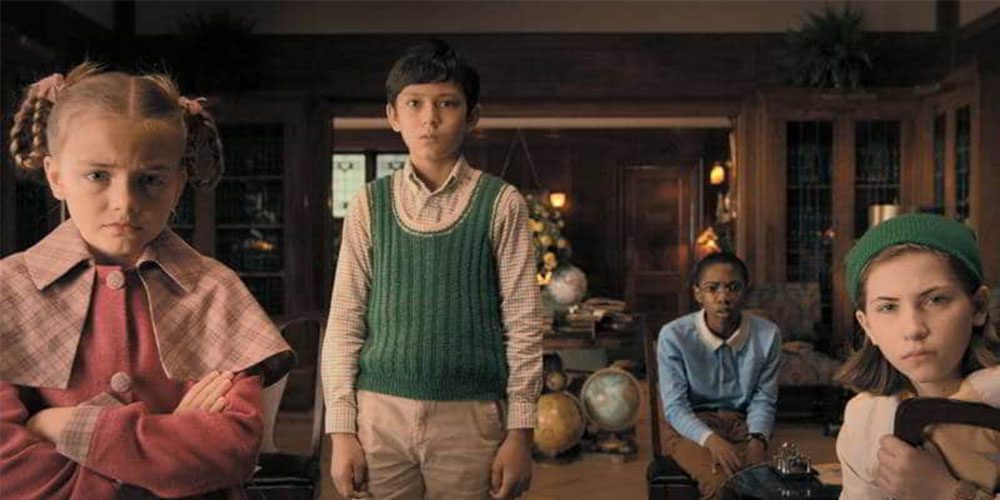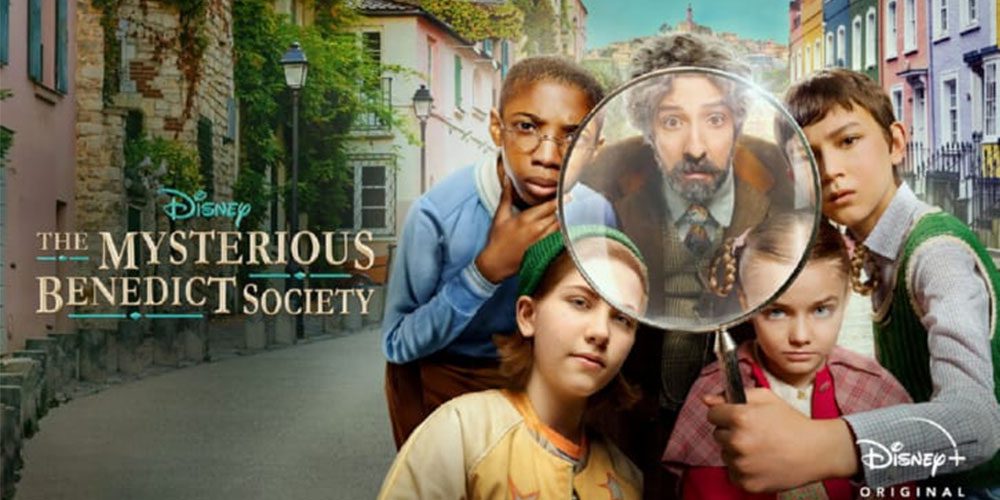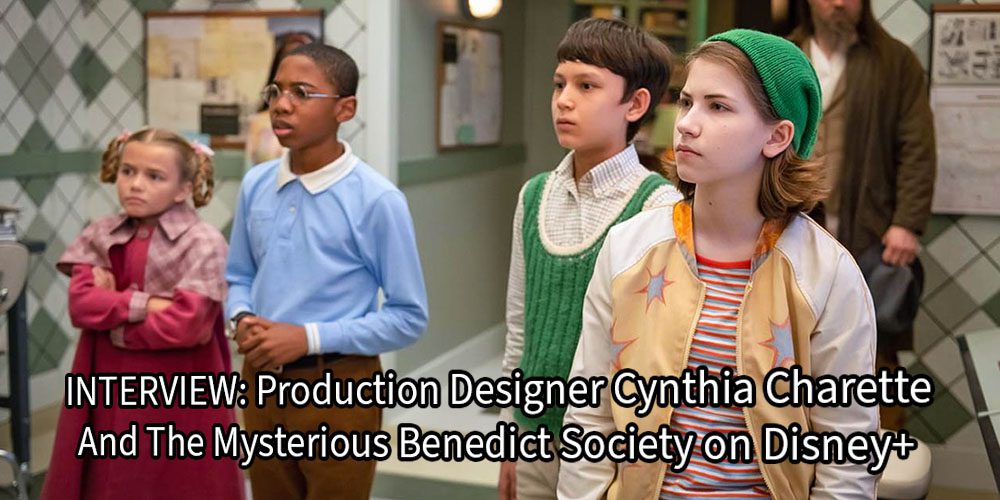The Mysterious Benedict Society is a Disney+ series based on a quartet of children’s books by Trenton Lee Stewart, where four children unite to save the world. Now wrapping up its second season, the show brought in producer designer Cynthia Charette (Pumpkinhead, You) to continue the unique, stylized vibe.
In the series, four children, Reynard (Mystic Inscho), “Sticky” (Seth Carr), Kate (Emmy DeOliveira), and Constance (Marta Kessler), are either orphans or outcasts recruited by Nicholas Benedict (Tony Hale). The kids are selected because they possess innovative, intelligent minds and unique, complementary skills. For example, Reynard is super-smart, Sticky remembers everything he reads, Kate is a clever creator with a bucket of tricks, and Constance is a force of nature even though she is the youngest member. The kids learn to be a team in season one while saving the world. In season two, they do a little globetrotting.
PopAxiom spoke with Cynthia Charette about her career and becoming a part of The Mysterious Benedict Society.
Another Level
Cynthia’s story starts in Nashville, Tennessee, where she was “the artist in school and knew I didn’t want to sit behind a desk.” But Cynthia “found theater. So I went to Syracuse University and majored in theatre design which I love. You get to create worlds on stage for the story.”
“I moved to New York and soon found that it was hard making a living in theatre,” she laughs, “I had a friend who was a director out of USC. He raised money for his first film, a low-budget horror movie called The Offspring. We had a budget of 250 thousand dollars, and it was an anthology.”
At this point, Cynthia was ready to work on anything she could get her hands on. “So, I went to Georgia to make the film.”
“For my first film out, we had an anthology that included the civil war, 1930s carnival, 1950s, and 1970s.” A wild mix of eras that require vastly different details. No pressure. “I was the designer, costume designer, and scene painter, and my crew were free kids from high school. I loved it. It hooked me. I knew I wanted to do it. I got to be creative and hands-on.”
Now hooked on production design, Cynthia moved to Los Angeles, and “after about six months, I got my next job.” Her burgeoning career took her into two projects — Shocker and A New Nightmare — with horror legend Wes Craven. “I loved Wes. He was a great mentor to me.”
Cynthia also worked with Stan Winston on his directorial debut Pumpkinhead. “You know, Stan Winston and Wes Craven allowed me to come to them with story and ideas. Like the burial ground in Pumpkinhead, that wasn’t even in the script. They’d let me take the visuals to another level.”

About The Mysterious Benedict Society
“I didn’t know anything about the show or story. But my agent called me saying they were interested,” she says about her path to becoming part of The Mysterious Benedict Society. “So I watched season one and thought, ‘No way, are you kidding me!’ I’ve been training for this show my whole life.”
“I was reflecting [recently] that some of these projects I did, one called Trusting Beatrice and another called Trading Mom with Sissy Spacek, they let me be so creative. I got to build worlds, and I mean every hand prop, everything that you see. Those projects were similar to what I’m doing now with the Mysterious Benedict Society.”
In the interview, Cynthia, who has an extensive portfolio, “put together all the creative stuff I’d done for other similar productions.”
The Mysterious Benedict Society is a show for tweens or early teens, and the production puts viewers in a vivid, detailed, and stylized world. Every scene looks like a flavor of ice cream. “That makes absolute sense. It’s a plan. It’s not by chance. We care about every detail.”
“I have to keep the crew on the same page but keep it fun and creative for them to get them engaged,” she says about her day-to-day work. “If we all work together, it’ll work, and you can tell the shows where they just gloss over certain things.”
That’s Not Blue
The Mysterious Benedict Society is a show full of vibrant, complimentary colors. Each character is distinct in attitude and motivation, and look. So how do they get such rich colors playing together? “Color is a gift that I have. I’m known for that. People say ‘blue,’ and I say, ‘No, that’s HC150, or that’s HC153’ I can tell the difference.”
“They didn’t have the color pronounced as I do, but I studied season one,” she says about taking the production design reigns for season two. Michael Wylie (Pushing Daisies) was the production designer on season one of the series, so what information did Cynthia receive? “I love Michael. The tone had been set. We studied it and looked at where we had to go. We’re traveling across Europe, so wherever we go, as I’m creating these different worlds, tonally, those ebb.”
The interplay between colors derived from the production and the costumes is worth watching The Mysterious Benedict Society. Especially for cinephiles. How does Cynthia and costume designer Chris Karvonides work together? “I’ll set a specific palette, then work with Chris and props and decorating to match things.”
“But sometimes Chris would have to make a costume before a set was even started,” she continues, reminding us that film and television productions are in constant motion. “Her trailer was right next to my trailer. I would run over there many times, look at her fabric, hold my palette up to it, and that’s the care we put into it. Especially when it comes to color, it works. We both cared that much.”
“When you get a show like Benedict where you can make a storybook come alive, we’re not going to let it down. We’ll raise the bar and keep it as high as it needs to stay.”

The Process
Production designers create the worlds around the actors we know and love to help tell the stories we can’t get enough of. Season two of The Mysterious Benedict Society takes things up a level, including vehicles, which brings up an essential aspect of production. “The vehicles showed up out of the junkyard. I’d have to design all those. The VFX team would get designs. It’s also important for production and visual FX to work together early on.”
“The first time I try to read it through,” she says about reading scripts and the start of the process. “It’s hard; my mind goes into visualization immediately. Then, the second pass, I start breaking it down to figure out all the sets.”
What does breaking it down for Cynthia entail? “We look at page count. If there are five pages on one set, we know they’ll spend more money, or it’s a bigger set. If I get an eighth of a page on one huge set, I talk to the producer about how we want to get that done or is it getting cut.”
“Our show has a lot of sets,” she adds, “and unfortunately, the budget takes priority. Sometimes you have to fight for a set because you feel it’s important.”
Wrapping Up
Cynthia’s influences include films like “Mary Poppins and Chitty Chitty Bang Bang, then Beetlejuice and Lemony Snickets, just creative worlds. But also films from the 30s, the Art Deco, and glamour. I either love fantasy, like joyful fantasy, or absolute beauty. Anything beautifully designed.”
“It’s not in my DNA to blow up and kill,” she laughs, “But designing beauty and worlds. Never Ending Story is another favorite of mine. I’d love to do a period piece like Pride and Prejudice. I also love Succession. But I would love to do a remake of something glamorous from the 30s or 40s.
Season two of The Mysterious Benedict Society is now available on Disney+. So, what’s next for Cynthia? “I’m busy on other projects until we hear about season three of Benedict.”
Is The Mysterious Benedict Society on your watch list?
Thanks to Cynthia Charette and Metro PR
for making this interview possible.
Find more interviews from Ruben R. Diaz!


